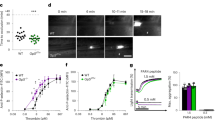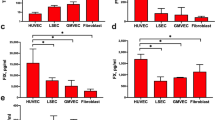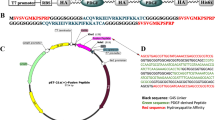Abstract
Transforming growth factor β1 (TGF–β1) is a platelet–derived cytokine involved in both normal wound healing and scarring. We show that human platelets contain two pools of latent TGF–β1, which constitute more than 95% of the total TGF–β assayed in whole platelets. During clotting, one pool, the large latent TGF–β complex consisting of latent TGF–β binding protein (LTBP), the latency–associated peptide (LAP) and the 25–kD mature TGF–β1 dimer is released into the serum. A second pool, which contains LAP but not LTBP, is retained in the clot, but can be released by RGD peptide. When the clot is dissolved by plasmin this bound TGF–β1 is gradually activated and released. If similar mechanisms operate in vivo, the clot will act as a slow–release capsule of TGF–β1 activity during wound healing.
This is a preview of subscription content, access via your institution
Access options
Subscribe to this journal
Receive 12 print issues and online access
$209.00 per year
only $17.42 per issue
Buy this article
- Purchase on Springer Link
- Instant access to full article PDF
Prices may be subject to local taxes which are calculated during checkout
Similar content being viewed by others
References
Massague, J. The transforming growth factor-β family. Annu. Rev. Cell Biol. 6, 597–641 (1990).
Sporn, M.B. & Roberts, A.B. Transforming growth factor β: Recent progress and new challenges. J. Cell Biol. 119, 1017–1921 (1992).
Olsen, D., Higley, H., Carillo, P., Gerhardt, C. & Ksander, G. The role of TGF-β in soft-tissue wound repair. J. Cell Biochem. 17E, 106 (1993).
Noh, J.W., Wiggins, R. & Phan, S.H. Urine transforming growth factor β activity is related to the degree of scarring in crescentic nephritis in the rabbit. Nephron 63, 73–78 (1993).
Logan, A. et al. Effects of transforming growth factor β1 on scar production in the injured central nervous system of the rat. Eur. J. Neurosci. 6, 355–363 (1994).
Shah, M., Foreman, D.M. & Ferguson, M.J.W. Neutralising antibody to TGF-β1 and 2 reduces cutaneous scarring in adult rodents. J. Cell Sci. 107, 1137–1157 (1994).
Shah, M., Foreman, D.M. & Ferguson, M.J.W. Control of scarring in adult wounds by neutralising antibody to transforming growth factor β. Lancet 339, 213–214 (1992).
Border, W.A. et al. Natural inhibitor of transforming growth factor β protects against scarring in experimental kidney disease. Nature 360, 361–364 (1992).
Assoian, R.K. & Sporn, M.B. Type beta transforming growth factor in human platelets: Release during degranulation and action on vascular smooth muscle cells. J. Cell Biol. 102, 1712–1733 (1986).
Wakefield, L.M., Smith, D.M., Flanders, K.C. & Sporn, M.B. Latent transforming growth factor β from human platelets. J. biol. Chem. 263, 7646–7654 (1988).
Miyazono, K., Hollman, U., Wornstadt, C. & Heldin, C-H. Latent high molecular weight complex of transforming growth factor β1: Purification from human platelets and structural characterisation. J. biol. Chem. 263, 6407–6417 (1988).
Lyons, R.M., Keski-Oja, J. & Moses, H.L. Proteolytic activation of latent transforming growth factor β from fibroblast conditioned medium. J. Cell Biol 106, 1659–1665 (1988).
Lyons, R.M., Gentry, L.E., Purchio, A.F. & Moses, H.L. Mechanism of activation of latent recombinant transforming growth factor β by plasmin. J. Cell Biol 110, 1361–1367 (1990).
Grainger, D.J., Kemp, P.R., Liu, A.C., Lawn, R.M. & Metcalfe, J.C. Activation of transforming growth factor-β is inhibited in transgenic apolipoprotein(a) mice. Nature 370, 460–462 (1994).
Harpel, J.G., Metz, C.N., Kojima, S. & Rifkin, D.B. Control of transforming growth factor-β activity: Latency versus activation. Prog. Growth Factor Res. 4, 321–335 (1992).
Grainger, D.J. et al. Proliferation of human smooth muscle cells promoted by lipoprotein(a). Science 260, 1655–1658 (1993).
Grainger, D.J., Mosedale, D.E., Metcalfe, J.C., Weissberg, P.L. & Kemp, P.R. Active and total TGF-β in human sera, platelets and plasma. Clin. chim. Acta 235, 11–31 (1995).
Kanzaki, T. et al. TGF-β1 binding protein: A component of the large latent complex of TGF-β1 with multiple repeat sequences. Cell 61, 1051–1061 (1990).
Dennis, P.A. & Rifkin, D.B. Cellular activation of latent transforming growth factor β requires binding to the cation-independent mannose 6-phosphate/insulin-like growth factor type II receptor. Proc. natn. Acad. Sci U.S.A. 88, 580–584 (1991).
Kojima, S., Nara, K. & Rifkin, D.B. Requirement for transglutaminase in the activation of latent transforming growth factor β in bovine endothelial cells. J. Cell Biol. 121, 439–448 (1993).
Calrete, J.J. Clues for understanding the structure and function of a prototypic human integrin: The platelet glycoprotein Ilb/IIIa complex. Thromb. Haemostasis 72, 1–15 (1994).
Border, W.A. & Noble, N.A. Transforming growth factor β in tissue fibrosis. New Engl. J. Med. 331, 1286–1292 (1994).
Border, W.A. & Ruoslahti, E. Transforming growth factor β: The dark side of tissue repair. J. clin. Invest. 90, 1–7 (1991).
Grainger, D.J. et al. The serum concentration of active transforming growth factor-β is severely depressed in advanced atherosclerosis. Nature Med. 1, 74–79 (1995).
Ivanovic, V., Melman, A., Davis-Joseph, B., Valcic, M. & Geliebter, J. Elevated plasma levels of TGF-β1 in patients with invasive prostate cancer. Nature Med. 1, 282–283 (1995).
Anscher, M.S., Peters, W.P., Reisenbicher, H., Petros, W.P. & Jirtle, R.L. Transforming growth factor β as a predictor of liver and lung fibrosis after autologous bone marrow transplantation for advanced breast cancer. New Engl. J. Med. 328, 1592–1598 (1993).
Miyazono, K., Olafsson, A., Colosetti, P. & Heldin, C.-H. A role for the latent TGF-β1-binding protein in the assembly and secretion of TGF-β1. EMBO J. 10, 1091–1101 (1991).
Grainger, D.J., Weissberg, P.L. & Metcalfe, J.C. Tamoxifen decreases the rate of proliferation of rat vascular smooth muscle cells in culture by inducing the production of transforming growth factor β. Biochem. J. 294, 109–112 (1993).
Author information
Authors and Affiliations
Rights and permissions
About this article
Cite this article
Grainger, D., Wakefield, L., Bethell, H. et al. Release and activation of platelet latent TGF–β in blood clots during dissolution with plasmin. Nat Med 1, 932–937 (1995). https://doi.org/10.1038/nm0995-932
Received:
Accepted:
Issue Date:
DOI: https://doi.org/10.1038/nm0995-932
This article is cited by
-
Alkaline shear-thinning micro-nanocomposite hydrogels initiate endogenous TGFβ signaling for in situ bone regeneration
npj Regenerative Medicine (2023)
-
Stable CAD patients show higher levels of platelet-borne TGF-β1 associated with a superior pro-inflammatory state than the pro-aggregatory status; Evidence highlighting the importance of platelet-derived TGF-β1 in atherosclerosis
Journal of Thrombosis and Thrombolysis (2022)
-
Thrombocytopenia: is it a prognostic factor for development of post-hemorrhagic hydrocephalus in neonates?
Child's Nervous System (2021)
-
In vivo canine study of three different coatings applied to p64 flow-diverter stents: initial biocompatibility study
European Radiology Experimental (2019)
-
Computational analysis reveals the coupling between bistability and the sign of a feedback loop in a TGF-β1 activation model
BMC Systems Biology (2017)



